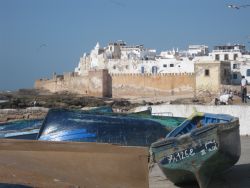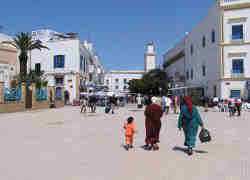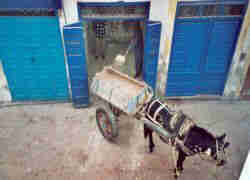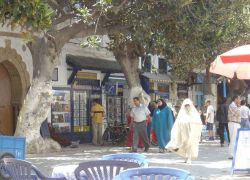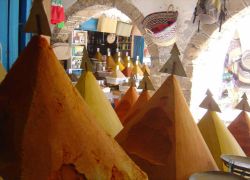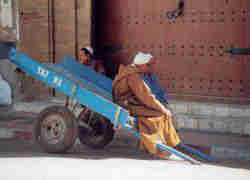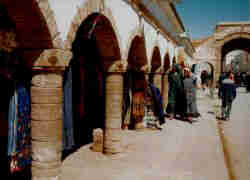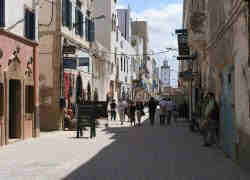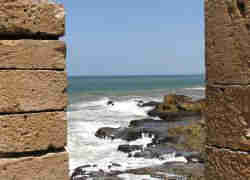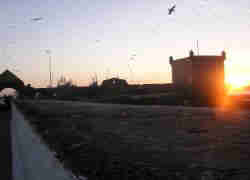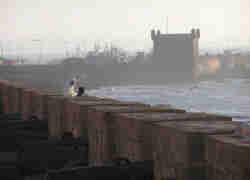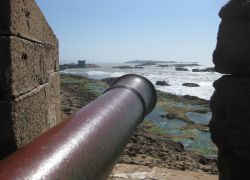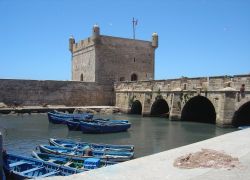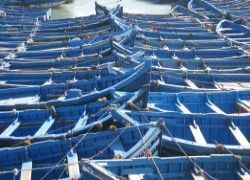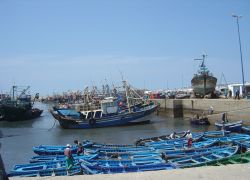History
Essaouira - “the jewel of the Atlantic” - is a small fortified port on the same latitude as Marrakech,
between Safi and Agadir. see Morocco map
Since the first century B.C., there has been a small settlement on the Purple Islands, so-called because
the murex, a mollusc from which the colour purple was extracted, was found in its waters.
In the 15th century, the Portuguese then came and built the first fortifications. The Scala is worthy of
special mention. The city was then given the name Mogador.
Later, in the 18th century, merchants from Europe also arrived and the city began to enjoy its Golden Age.
The sultan of that time, Sidi Mohamed ben Abdallah, decided to make it the most important port of the kingdom.
He permitted different tribes to inhabit the city and consulates to be established: Denmark first, then France,
Brasil and Portugal. This intelligent and tolerant prince even welcomed an important Jewish community, which
contributed greatly to the development of the city. Mogador became the first Moroccan port to trade with the
non-islamic world. It also became the destination for caravans bringing African riches from Timbuctu.
The town-planning was entrusted to the Frenchman Théodore Cornut, disciple of Vauban, who gave the city its
present look, building ramparts and straight, wide streets.
However, the end of the big caravans and the development of Casablanca caused the decline of the city and it
became less and less important.
Finally, in the 20th century, after the independence of the country, the town was given the name Essaouira- ‘the well designed’.
However, in the seventies, the hippies discovered the town again and it became a fashionable destination,
where even pop stars of that time - Jimmy Hendrix, Cat Stevens and others - liked to stay.
Fascinated by its natural beauty, the film producer Orson Welles made his famous movie ‘Othello’ there.
Today, Essaouira, recently classified by Unesco as part of the World Heritage, should not be missed when
visiting Morocco.
Tolerance, a multi-confessional tradition, the mildness of its climate and the kindness
of its inhabitants make a visit worthwhile.
The old city
When entering one of the monumental gates, Bab Sbâa, Bab Marrakech or Bab Doukhala, you find yourself in
the midst of an animated and joyful crowd, where everybody is going about his own business.
There are no motor vehicles here, everything is carried by carts sometimes drawn by mules. What fascinates
visitors are the white-washed house walls, the blue doors and windows which are reminiscent of Mediterranean
islands. Owing to the straight main streets, you will have no problem finding your way and even if you get
lost in the numerous small lanes, sooner or later you will find a main street again... or a dead-end.
What is also worth seeing is the central market with its numerous butcher shops. Under the market arcades you
can find all kinds of merchants selling vegetables, spices and seeds, meat and fish.
To get away from the hustle and bustle of the marketplace, a glimpse at the ocean view from the Scala -
the fortified place of the city - is breathtaking with its beautiful battery of canons pointing out to the sea.
Sooner or later, you will come to Moulay Hassan Square lined by trees and coffee bars where you can
drink a peppermint tea and watch the coming and going of the Souiris, the inhabitants of Essaouira,
who are very fond of this square.
A bit further on, past the Gate of the Marine, you will reach the port and shipyard, where ships are still
built in the traditional way.
Photos
Handicraft
In the Jewish community there were jewellers who made their own jewels but when they left the country, this
activity stopped. However, you can still find some shops that sell mainly silver items.
Wood carving is in fact the main craft in Essaouira. You will find some wonderful items made of thuya wood,
inlaid with other kinds of wood such as lemon tree or ebony. The objects range from simple key cases to ornate
cupboards, desks, stools and tables. Thuya wood, a typical scent of the medina, will stay in your memories
because of the numerous workshops under the arcades of the Scala.
Of course, you can find shops selling typical Moroccan items such as carpets, blankets, babouches, iron or
copper articles, pottery, ceramic, tables covered with tiles. Some objects are actually made in the shops
themselves: lamps covered with leather and decorated with henna, musical instruments (djembés, guembris).
Photos
Painting
In the past, Essaouira attracted poets, artists and other creative talents, but modern art and especially
painting have found here again a favourable environment. It would not be exaggerated to speak of an
‘Essaouira School’ representing a mixture of modern and naïve art, which finds its inspiration in the Gnaoua
culture. There emerged a real “cradle” of artists, of whom the most famous is Mohamed Tabal.
Although without any academic or artistic education, one day they were inspired and expressed their creativity
on canvas, producing some great and sometimes astonishing works of art.
In the meantime, these artists have acquired global recognition and exhibit their work all over the world.
Photos
Music
Essaouira is famous for Gnaoua music, first introduced by the caravan men from Africa. The musicians play
on percussion instruments (djembés) and strings (guembris), and the dancers, entranced by the rhythm,
use castanets called krakeb.
Their shows or lilas are mostly organized in private circles and find their culmination at the June festival
of Gnaoua music, which has become internationally famous. It is now open to other forms of music and is
called Festival of World Music. In 2001, the king of raï-music Cheb Mami and in 2004, the Wailers, the former group of Bob Marley,
captivated the audience on Moulay Hassan Square.
Photos
The beach
The beaches are splendid and endless. They are visited in the morning by joggers and in the afternoon by
volley ball players and families. The picturesque bay of Essaouira, protected from the big waves of the
ocean by the Mogador islands, is a paradise for wind surfers thanks to the constant and strong winds
For surf enthusiasts, the coast offers some famous spots like Sidi Kaoki or Moulay Bouzarktoun, the former
in the south and the latter in the north of Essaouira.
Photos
The region of Essaouira
When leaving the town in the direction of Marrakech after about 2 km, you come to a wonderful panorama.
Then you go through forests of thuyas, eucalyptus and especially argan, which only grow in this area.
The argan trees produce nuts from which a delicious oil is made.
Photos
